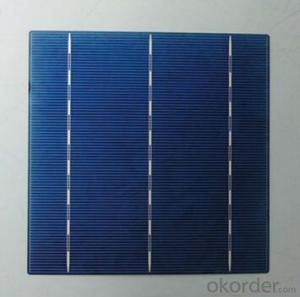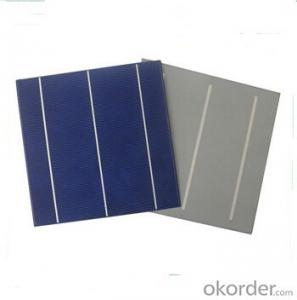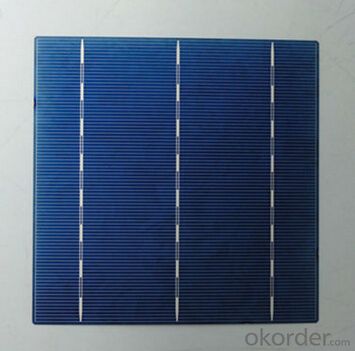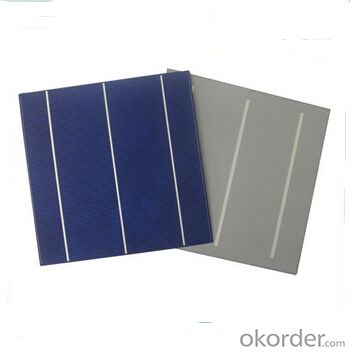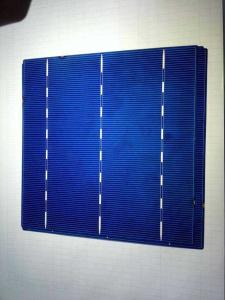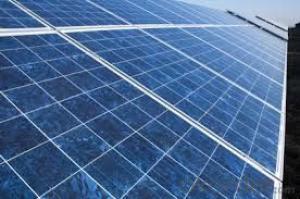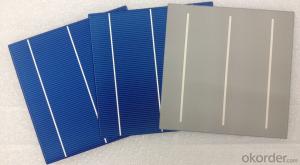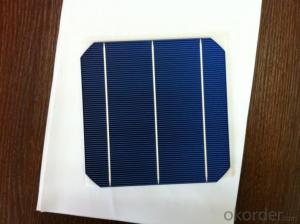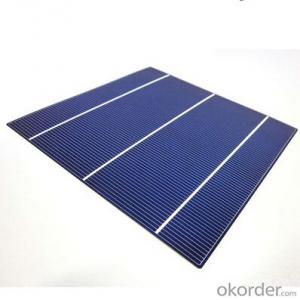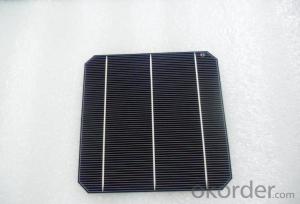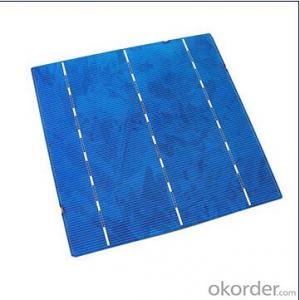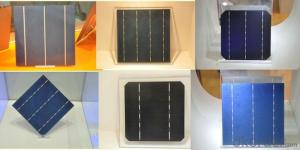Solaero Solar Cells - Monocrystalline High Quality 17.2% Efficiency
- Loading Port:
- Shanghai
- Payment Terms:
- TT OR LC
- Min Order Qty:
- 1000 pc
- Supply Capability:
- 1000000 pc/month
OKorder Service Pledge
OKorder Financial Service
You Might Also Like
Solar Cells:
Solar cells is made by solar wafer, it has three categories of solar cell right now, monocrystalline polycrystalline and thin film,These cells are entirely based around the concept PN junction, which is the critical part of solar module, it is the part that can convert the light energy into electricity, the thickness is from 180um to 200um, with even busbars to conduct electricity, textured cell can decrease diffuse reflection; they are often electrically connected and encapsulated as a module. Photovoltaic modules often have a sheet of glass on the front (sun up) side, allowing light to pass while protecting semiconductor wafers from abrasion and impact due to wind-driven debris, rain, hail, etc. Solar cells are also usually connected in series in modules, creating an additive voltage. Connecting cells in parallel will yield a higher current;With high quality and stable quality. Our Cells can greatly improve the performance of Solar Modules.
Features:
High efficiency and stable performance in photovoltaic conversion.
Advanced diffusion technique ensuring the homogeneity of energy conversion efficiency of the cell.
Advanced PECVD film forming, providing a dark blue silicon nitride anti-reflection film of homogenous color and attractive appearance.
High quality metal paste for back surface and electrode, ensuring good conductivity, high pulling strength and ease of soldering.
High precision patterning using screen printing, ensuring accurate busbar location for ease with automatic soldering a laser cutting.
Solar Cells Advantage:
• High efficiency and stable performance in photovoltaic conversion.
• Advanced diffusion technique ensuring the homogeneity of energy conversion efficiency of the cell.
• Advanced PECVD film forming, providing a dark blue silicon nitride anti-reflection film of homogenous color and attractive appearance.
• High quality metal paste for back surface and electrode, ensuring good conductivity, high pulling strength and ease of soldering.
• High precision patterning using screen printing, ensuring accurate busbar location for ease with automatic soldering a laser cutting.
Specifications:
Efficiency(%) | Pm(W) | Ump(V) | Imp(A) | Uoc(V) | Isc(A) | FF(%) |
19.20-20.00 | 4.67 | 0.547 | 8.542 | 0.64 | 9.15 | 79.79 |
19.00-19.20 | 4.63 | 0.543 | 8.515 | 0.639 | 9.11 | 79.43 |
18.80-19.00 | 4.58 | 0.542 | 8.441 | 0.638 | 9.1 | 78.8 |
18.60-18.80 | 4.53 | 0.54 | 8.382 | 0.637 | 9.084 | 78.23 |
18.40-18.60 | 4.48 | 0.536 | 8.354 | 0.636 | 9.062 | 77.7 |
18.20-18.40 | 4.43 | 0.533 | 8.31 | 0.635 | 9.033 | 77.22 |
18.00-18.20 | 4.38 | 0.532 | 8.234 | 0.634 | 8.987 | 76.88 |
17.80-18.00 | 4.33 | 0.529 | 8.189 | 0.633 | 8.951 | 76.45 |
17.60-17.80 | 4.29 | 0.527 | 8.128 | 0.632 | 8.922 | 75.96 |
17.40-17.60 | 4.24 | 0.525 | 8.066 | 0.629 | 8.902 | 75.63 |
Packaging & Delivery of Solar Cells
Carton Box Package and Deliver by air. It should be noticed that it should be avoid of water, sunshine and moist.
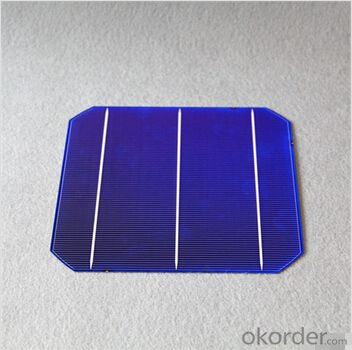
FAQ
We have organized several common questions for our clients,may help you sincerely:
①What price for each watt?
It depends on the efficiency of the solar cell, quantity, delivery date and payment terms.
②How long can we receive the product after purchase?
In the purchase of product within three working days, We will arrange the factory delivery as soon as possible. The pecific time of receiving is related to the state and position of customers.Commonly 7 to 10 working days can be served.
③Can you provide the peripheral products of the solar panels, such as the battery, controller, and inverter? If so, can you tell me how do they match each other?
Yes, we can, we have two companies for solar region, one is CNBM International, the other is CNBM engineering Co.
We can provide you not only the solar module but also the off grid solar system, we can also provide you service with on grid plant.
④What is your warranty of solar cell?
Our product can promise lower than 0.3% open box crack, we support claim after opening the box if it has crackm color difference or sth, the buyer should give pictures immediately, we can not accept the claim after the solar cell has assembled to solar panel.
• Timeliness of delivery
• ⑤How do you pack your products?
We have rich experience on how to pack the solar cell to make sure the safety on shipment, we could use wooden box or pallet as buyer's preference.
- Q: How are solar cells used in spacecraft?
- Solar cells are used in spacecraft to convert sunlight into electricity, providing a reliable and renewable source of power for various systems and instruments on board.
- Q: How long does it take to install solar cells on a rooftop?
- The time required to install solar cells on a rooftop can vary depending on various factors such as the size of the system, complexity of the installation, and the expertise of the installation team. On average, a residential rooftop solar installation can take anywhere from a few days to a couple of weeks. However, larger commercial installations may require more time. It's best to consult with a professional solar installer for a more accurate estimate based on your specific project.
- Q: How do solar cells perform in areas with high levels of light pollution?
- Solar cells perform less efficiently in areas with high levels of light pollution. Light pollution not only reduces the amount of natural sunlight reaching the solar cells but also introduces artificial light sources that can interfere with the cell's ability to absorb and convert sunlight into electricity. As a result, the overall performance and energy output of solar cells are compromised in such areas.
- Q: How do solar cells handle electromagnetic radiation?
- Solar cells handle electromagnetic radiation by converting it into electrical energy. When sunlight (which is a form of electromagnetic radiation) strikes the solar cell, it excites electrons, allowing them to flow through the material, creating an electric current. The materials used in solar cells are designed to efficiently absorb and convert a wide range of electromagnetic radiation, including visible light and some parts of the infrared and ultraviolet spectrum.
- Q: How do solar cells contribute to reducing carbon emissions?
- Solar cells contribute to reducing carbon emissions by converting sunlight into electricity without burning fossil fuels. As a clean and renewable energy source, solar cells help decrease the reliance on coal, oil, and gas power plants that emit greenhouse gases. By harnessing the sun's energy, they generate electricity with zero carbon emissions, thereby mitigating climate change and promoting a more sustainable future.
- Q: What is the role of bypass diodes in solar cell systems?
- The role of bypass diodes in solar cell systems is to prevent the loss of power due to shading or damage to individual solar cells. These diodes provide an alternate pathway for the flow of current, allowing the unaffected cells to continue generating electricity even if some cells are blocked or not functioning optimally. By minimizing the impact of shading or cell failure, bypass diodes help to maintain the overall efficiency and performance of the solar cell system.
- Q: Can solar cells be recycled?
- Yes, solar cells can be recycled. The process involves separating and recovering valuable materials like silicon, silver, and aluminum from the cells. This not only reduces waste but also allows for the reuse of these materials in the production of new solar cells.
- Q: Can solar cells be used to power large industrial facilities?
- Yes, solar cells can be used to power large industrial facilities.
- Q: Can solar cells be used for powering hotels?
- Yes, solar cells can be used for powering hotels. Solar energy is a clean and renewable source of power that can be harnessed through the use of solar cells, also known as photovoltaic panels. These panels convert sunlight into electricity, which can be utilized to power various appliances and systems in hotels. By installing solar panels on rooftops or in open spaces, hotels can reduce their reliance on conventional energy sources, lower their carbon footprint, and potentially save on electricity costs in the long run.
- Q: Can solar cells be installed on vehicles?
- Yes, solar cells can be installed on vehicles. In fact, many electric and hybrid vehicles are equipped with solar panels on their roofs or hoods to harness solar energy and supplement their power source. These solar cells help to charge the vehicle's battery and increase its overall efficiency, reducing the reliance on traditional charging methods and improving sustainability.
Send your message to us
Solaero Solar Cells - Monocrystalline High Quality 17.2% Efficiency
- Loading Port:
- Shanghai
- Payment Terms:
- TT OR LC
- Min Order Qty:
- 1000 pc
- Supply Capability:
- 1000000 pc/month
OKorder Service Pledge
OKorder Financial Service
Similar products
Hot products
Hot Searches
Related keywords
